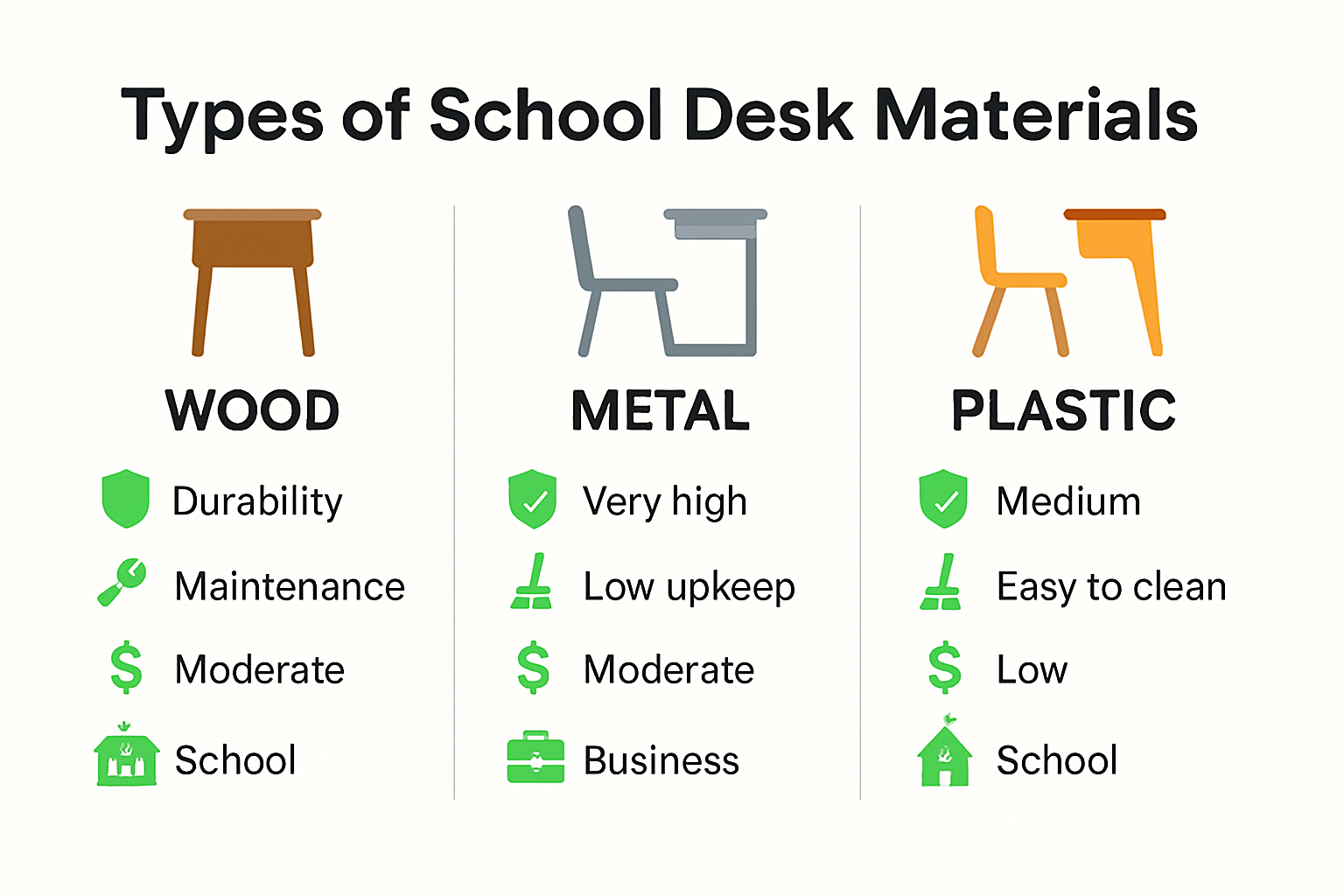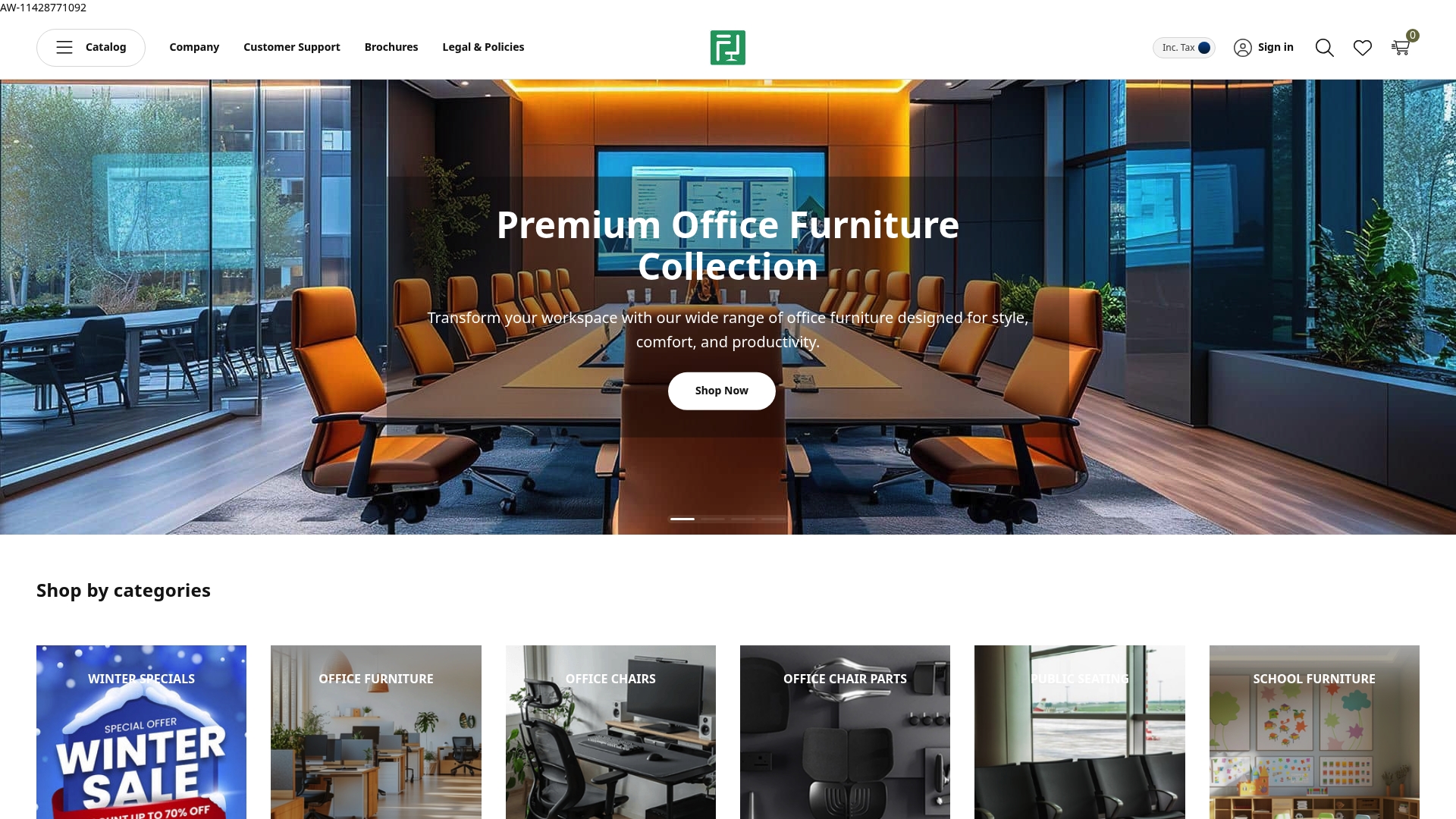Choosing the Best School Desk for Your Business in 2025
Jul 12, 2025
Choosing the Best School Desk for Your Business in 2025

Choosing school desks for your business in 2025 sounds simple, right? Think again. The price for a single school desk in Southern Africa can range from R500 to R2,500 depending on material and design. You might expect the most expensive desks are always the best buy. In fact, picking the wrong type could mean higher hidden costs and unhappy students. Here’s what you actually need to look for if you want desks that truly support both your budget and the people using them.
Table of Contents
- Understanding School Desk Types And Materials
- Exploring Material Options For School Desks
- Emerging Trends In School Desk Materials
- How To Select The Right School Desk For Your Needs
- Assessing Functional Requirements
- Ergonomic And Comfort Considerations
- Budget And Long-Term Investment Strategy
- School Desk Pricing And Bulk Purchase Options In Southern Africa
- Understanding Pricing Structures
- Bulk Purchase Strategies
- Negotiation And Cost Management
- Maintenance Tips And Longevity For School Desks
- Cleaning And Sanitization Protocols
- Material-Specific Maintenance Approaches
- Long-Term Preservation Strategies
Quick Summary
| Takeaway | Explanation |
|---|---|
| Understand Desk Materials | Selecting the right material, such as wood, metal, or advanced plastics, impacts durability, maintenance, and overall value for school desks. |
| Evaluate Functional Requirements | Assess specific institutional needs regarding space, mobility, and age group compatibility to choose suitable desk designs. |
| Budget for Long-Term Investment | Consider initial costs alongside potential longevity and maintenance expenses to ensure a sound financial decision on furniture purchases. |
| Implement Regular Maintenance | Establish cleaning protocols and material-specific maintenance approaches to extend the lifespan and functionality of desks. |
| Explore Bulk Purchase Options | Leverage consolidated purchasing agreements and assess total cost of ownership to maximize value while managing budget constraints. |
Understanding School Desk Types and Materials
Selecting the right school desk involves understanding the complex landscape of materials and design that impact learning environments. Business owners and educational institutions must consider multiple factors when choosing furniture that supports student comfort, durability, and productivity.

Exploring Material Options for School Desks
The choice of school desk material significantly influences its performance, longevity, and overall value. Explore our ergonomic furniture solutions to understand how material selection impacts workspace design.
Wood remains a classic and versatile material for school desks. According to Research and Markets, wood-based furniture offers natural aesthetics and remarkable durability. Manufacturers typically treat wooden desks with protective finishes that resist scratches, moisture, and daily wear. Hardwoods like oak and maple provide exceptional strength, while more affordable options like pine offer cost-effective alternatives for budget-conscious institutions.
Metal school desks represent another critical category in educational furniture. Global Growth Insights reports that metal furniture, constructed from steel or aluminum, delivers unparalleled robustness for high-traffic learning spaces. These desks withstand significant physical stress and can be powder-coated to enhance corrosion resistance and aesthetic appeal. Steel frame desks are particularly popular in secondary schools and technical training environments where durability is paramount.
Emerging Trends in School Desk Materials
Plastic school furniture has experienced substantial transformation in recent years. Modern plastic desks are no longer considered cheap alternatives but sophisticated solutions addressing sustainability concerns. According to industry research, recycled plastic furniture adoption has surged, reflecting growing environmental consciousness among educational institutions.
Advanced plastic formulations now offer improved durability, lightweight construction, and resistance to bacterial growth. Injection-molded plastic desks are particularly prevalent in primary and kindergarten settings, providing easy-to-clean surfaces that meet strict hygiene standards. Some manufacturers are developing hybrid materials that combine plastic’s practicality with wood’s aesthetic warmth, creating innovative solutions for modern learning spaces.
Businesses and educational institutions must evaluate several critical factors when selecting school desk materials:
- Durability: Assess expected usage intensity and potential wear patterns
- Maintenance Requirements: Consider cleaning ease and long-term upkeep costs
- Ergonomic Design: Prioritize student comfort and proper posture support
- Budget Constraints: Balance quality with financial limitations
Ultimately, the ideal school desk transcends mere functionality. It becomes an integral component of the learning environment, supporting student engagement, comfort, and academic performance. Careful material selection reflects an institution’s commitment to creating supportive, inspiring educational spaces that nurture student potential.
By understanding the nuanced characteristics of different desk materials, businesses can make informed decisions that align with their specific educational or training requirements.
To help you compare the main school desk materials, the following table summarises their key characteristics:
| Material | Durability | Maintenance | Typical Use Case | Cost Range (per unit) |
|---|---|---|---|---|
| Wood | High (esp. hardwood) | Moderate (may need refinishing) | Secondary schools, prestige settings | R1,200 – R2,500 |
| Metal | Very High | Low (needs rust check) | High-traffic, technical, secondary | R1,000 – R2,200 |
| Plastic | Moderate–High | Low (easy to clean) | Primary, kindergarten, modern spaces | R500 – R1,800 |
| Hybrid (Wood/Plastic) | High | Low to Moderate | Versatile/modern classrooms | R1,200 – R2,200 |
How to Select the Right School Desk for Your Needs

Choosing the right school desk requires a strategic approach that goes beyond basic functionality. Business owners and educational institutions must consider multiple dimensions to ensure their furniture investment supports learning environments effectively.
Assessing Functional Requirements
Selecting appropriate school desks begins with a comprehensive evaluation of specific institutional needs. Explore our ergonomic furniture solutions to understand comprehensive workspace design principles.
According to UNICEF’s School Furniture Design Guidelines, innovative furniture design should prioritize locally produced materials that are easy to assemble, low maintenance, and child-friendly. This approach ensures not only functional performance but also supports local manufacturing ecosystems.
Key functional considerations include:
- Space Optimization: Measure classroom dimensions and student capacity
- Mobility Requirements: Determine need for movable or fixed desk configurations
- Age Group Compatibility: Select desk sizes appropriate for specific student age ranges
- Usage Intensity: Evaluate expected daily usage and potential wear patterns
Ergonomic and Comfort Considerations
Ergonomics play a critical role in student performance and health. Desks must support proper posture, accommodate different body sizes, and provide comfortable learning environments. Research from the Western Cape Education Department emphasizes the importance of standardized furniture that meets specific educational infrastructure requirements.
Additional ergonomic factors include:
- Adjustable height mechanisms
- Appropriate desk-to-chair ratio
- Support for different learning activities
- Compatibility with technological devices
Budget and Long-Term Investment Strategy
While initial cost remains important, businesses should approach school desk selection as a long-term investment. Cheaper options might require frequent replacement, ultimately increasing total ownership costs. The South African Department of Basic Education recommends comprehensive evaluations that consider durability, maintenance requirements, and potential long-term savings.
Strategic budget considerations include:
- Initial purchase price
- Expected lifespan of furniture
- Maintenance and repair costs
- Potential for future reconfiguration
Successful school desk selection transcends simple procurement. It represents a holistic approach to creating supportive, adaptable learning environments that enhance student engagement and institutional efficiency. By carefully analyzing functional requirements, ergonomic needs, and long-term financial implications, businesses can make informed decisions that deliver substantial educational value.
Remember that each educational setting is unique. What works perfectly in one environment might not suit another. Consultation with furniture experts, thorough research, and careful assessment of specific institutional requirements will guide you toward the most appropriate school desk solutions.
School Desk Pricing and Bulk Purchase Options in Southern Africa
Navigating school desk procurement in Southern Africa requires strategic financial planning and understanding of regional market dynamics. Business owners and educational institutions must develop comprehensive approaches to maximize value while managing budget constraints.
Understanding Pricing Structures
Explore our budget-friendly furniture solutions to discover cost-effective options for institutional purchasing. Pricing for school desks varies significantly based on multiple factors including material quality, manufacturing complexity, and regional economic conditions.
According to the Department of Basic Education’s supplier guidelines, prospective purchasers must navigate a complex procurement landscape. The Public Finance Management Act (PFMA) establishes strict protocols for institutional purchasing, emphasizing transparency and competitive pricing. Typical price ranges for school desks in Southern Africa can vary from R500 to R2,500 per unit, depending on specifications and material composition.
Key pricing considerations include:
- Material Costs: Wood, metal, and plastic desks have distinct pricing structures
- Manufacturing Complexity: Custom designs and specialized features increase unit prices
- Bulk Purchasing Discounts: Larger orders typically reduce per-unit expenses
- Delivery and Installation: Additional costs beyond base product pricing
Bulk Purchase Strategies
The Western Cape Education Department provides insights into institutional purchasing strategies. Schools and businesses can optimize procurement through several approaches:
- Consolidated purchasing agreements
- Annual tender processes
- Collaborative procurement with multiple institutions
- Leveraging government procurement frameworks
Institutions should carefully evaluate total cost of ownership, considering factors beyond initial purchase price. Durability, maintenance requirements, and long-term performance significantly impact overall financial investment.
Negotiation and Cost Management
Successful school desk procurement demands sophisticated negotiation skills. Businesses can implement several strategies to manage costs effectively:
- Request comprehensive quotes from multiple suppliers
- Negotiate volume-based discounts
- Consider extended warranty options
- Evaluate lifecycle costs of furniture
Regional variations play a crucial role in pricing. Southern African markets demonstrate unique procurement challenges, with factors like transportation costs, local manufacturing capabilities, and economic conditions influencing final pricing.
Government institutions often have predefined procurement processes. The Department of Basic Education recommends comprehensive evaluation approaches that balance cost-effectiveness with quality requirements. This involves detailed specification development, thorough market research, and strategic vendor selection.
Business owners should approach school desk procurement as a strategic investment rather than a simple purchasing decision. By understanding complex pricing mechanisms, leveraging bulk purchase opportunities, and implementing sophisticated negotiation strategies, institutions can secure high-quality furniture solutions that meet both educational and budgetary requirements.
Remember that the lowest price does not always represent the best value. Comprehensive assessment of quality, durability, and long-term performance remains critical in making informed purchasing decisions for school furniture.
The following table outlines key cost factors to consider when purchasing school desks in Southern Africa:
| Cost Factor | Description |
|---|---|
| Material Type | Wood, metal, plastic or hybrid |
| Unit Price Range | R500 – R2,500 per desk |
| Manufacturing Complexity | Customisation, special features add to cost |
| Bulk Order Discounts | Larger orders reduce unit price |
| Delivery & Installation | Additional costs for transport and setup |
| Maintenance & Lifespan | Ongoing costs beyond purchase |
Maintenance Tips and Longevity for School Desks
Ensuring the durability and performance of school desks requires a strategic approach to maintenance and care. Business owners and educational institutions must implement comprehensive maintenance protocols to maximize their furniture investment and create safe, functional learning environments.
Cleaning and Sanitization Protocols
Explore our expert maintenance recommendations to understand comprehensive furniture care strategies. According to Cape Argus research, regular cleaning of classroom desks is critical in reducing the risk of illness and maintaining a healthy learning environment.
Effective cleaning strategies include:
- Daily Surface Cleaning: Use appropriate disinfectant solutions compatible with desk materials
- Microfiber Cloth Techniques: Prevent scratching while effectively removing dust and germs
- Specialized Cleaning Agents: Select products that do not damage desk finishes
- Periodic Deep Cleaning: Comprehensive sanitization at regular intervals
Material-Specific Maintenance Approaches
The South African Department of Basic Education emphasizes the importance of maintaining furniture in alignment with national standards. Different desk materials require unique maintenance considerations:
- Wooden Desks: Apply protective sealants, avoid excessive moisture, sand and refinish periodically
- Metal Desks: Check for rust, apply protective coatings, tighten loose connections
- Plastic Desks: Use mild detergents, inspect for cracks, replace damaged components promptly
Long-Term Preservation Strategies
A study on public school infrastructure management in Gauteng Province highlights that community involvement and proactive maintenance are crucial in preventing facility deterioration. Institutions should implement comprehensive preservation strategies:
- Conduct quarterly comprehensive inspections
- Train staff in proper furniture maintenance
- Establish repair and replacement protocols
- Document maintenance activities
- Budget for ongoing maintenance and potential replacements
Regular maintenance extends beyond cleaning. Institutions must develop holistic approaches that consider environmental factors, usage patterns, and potential wear mechanisms. Proper storage during school holidays, protecting desks from extreme temperatures, and implementing usage guidelines can significantly extend furniture lifespan.
Businesses and educational institutions should view desk maintenance as an ongoing investment rather than a periodic task. By developing systematic maintenance protocols, organizations can:
- Reduce long-term replacement costs
- Maintain a professional and hygienic learning environment
- Demonstrate commitment to student welfare
- Optimize furniture performance and durability
Ultimately, successful school desk maintenance requires a proactive, comprehensive approach. By understanding material-specific care requirements, implementing rigorous cleaning protocols, and developing long-term preservation strategies, institutions can ensure their furniture remains functional, safe, and aesthetically pleasing for years to come.
Frequently Asked Questions
What are the key factors to consider when choosing school desks in 2025?
Choosing school desks should focus on material durability, ergonomic design, functional requirements, and budget considerations to ensure a supportive learning environment.
How much does a school desk typically cost in Southern Africa?
In Southern Africa, the price of a school desk can range from R500 to R2,500, depending on the materials and design involved.
What types of materials are best for school desks?
Wood, metal, plastic, and hybrid materials each offer different benefits. Wood and metal provide durability, while modern plastics are lightweight and easy to maintain.
How can I negotiate better pricing for bulk purchases of school desks?
To negotiate better pricing, request quotes from multiple suppliers, consider volume discounts, and explore government procurement frameworks for potential savings.
Transform Your School or Business with Desks That Last and Inspire
Are you frustrated by school desks that quickly wear out, leave students uncomfortable, or cause escalating maintenance costs? The article above shows exactly how tough it can be to balance your budget with quality, durability and ergonomic support. Many businesses in Southern Africa struggle to find desks that stand up to high-traffic use but do not want to compromise on design or comfort. If you want solutions that match your functional and investment goals, there is practical help closer than you think.

With Office Stock, you get trusted expertise and a wide range of proven options that line up perfectly with your budget, durability and style requirements. From ergonomic chair solutions for staff wellness to high-performance classroom desks that support learning every day, every product is chosen for South African conditions and standards. Do not settle for another year of hidden costs or awkward classroom layouts. Take the next step to compare, plan and get a personalised quote by visiting https://officestock.co.za now. Act today to secure school desks that truly support your teams, your students, and your peace of mind.
Recommended
- Delta Polyurethane Operator Office Chair | Office Stock
- Senator Executive Desk in Veneer Wood-3 | Buy Office Furniture Online - Office Stock
- Cre8 Ergonomic Office Chair | Buy Office Chairs Online - Office Stock
- NON-REFLECTIVE MAGNETIC BOARD 3000*1200mm | Buy Uncategorized Online - Office Stock
- Eco Desk Letter Tray | Buy Uncategorized Online - Office Stock
- BackLogic Ergonomic Office Chair | Buy Office Chairs Online - Office Stock
